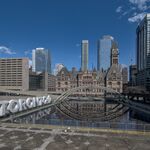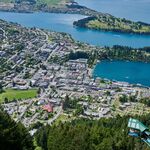If you don't understand the question, then I would suggest that you don't understand the main problem you are trying to resolve.
Take a look at streets such as Finch, Sheppard or Lawrence. Then look both north and south of those streets. Those neighbourhoods also need to be able to access transit. If you putting stops every kilometre apart, there is the potential that people will have to walk 500 metres just to get to the major street, and then another 500 metres to access each stop. (And there are some places where people would have to walk almost a kilometre, but those are fewer, and generally in less dense areas.)
Toronto has done a good job of getting people within a reasonable walking distance from transit, but cutting stops is not going to help that.
Dan
I think we need to be a bit more fine-grained/nuanced.
Distance between stops should vary by mode, by capacity needs and by median distance of trip traveled.
At all levels of service, in all modes we have some stops that are objectively (as much as anything can be), too close together; we also have some gaps that are excessive.
St Clair has perhaps the most infamous of the too close together stops, Bathurst and Vaughan at a whopping 159M apart
In that case, consolidating the two stops as Bathurst-Vaughan leaves you a distance that is still only 321M to Wychwood; and depending on exact stop positions, ~500M to Christie.
There are dozes of stops across the City on surface routes that are under ~300M apart, a number under 200M as well. Surely we can generally agree that is simply too close, particularly if removing a stop doesn't result in gap larger than ~400M
***
When it comes to what is meant to be rapid transit, LRT in its own ROW and/or underground, stop distances need to be larger, to have them too close together is capacity and speed limiting in a way that makes them much less effective and desirable as transit, and inflates operating costs.
Its perfectly reasonable to have underground lines with 1km gaps, anymore than that, and supplementary local service makes sense to give you better 'last mile connections.
The challenge with surface LRT is whether or not you want to run a supplementary service to fill gaps. In general the TTC lacks enthusiasm for this idea, which means closer stops are in order.
That said, I don't think you want them to come in much under 500M.
The example you out line of someone mid-way between major roads/transit in Scarborough is an interesting one; and one not easily addressed by any single project.
But lets try to look at a typical 'last mile gap'.
I've selected Eglinton-Lawrence, and VP - Warden as that block.
The N-S distance is 2km, leaving a maximum 1km walk, plus, the E-W distance between a major N-S road and one's home.
The Pharmacy-VP gap is ~400m for a max distance of 200M; while the Pharmacy-Warden gap is ~800m for a max distance of 400M.
In that context, if you keep stops on Eglinton and Lawrence 500M apart; if someone mid-way between Egliinton and Lawrence chose to walk to the E-W route, their max walk is ~1.4km
But why would they do this? There are N-S routes on each of VP, Pharmacy and Warden.
Assuming they would go the nearest transit stop, the maximum distance would be ~ 650M if they were mid-way between Warden and Pharmacy and mid-way between stops on those routes at 500M apart.
In that worst case scenario, I don't feel that walk is an extraordinary ask.
That said, I have no difficulty with the local bus on those N-S routes having stops slightly closer together.
But worth noting, if you shave the distance to 350M between stops; you're only reducing the maximum walk by 75M; but you're adding 5 stops for a passenger traveling from
Lawrence down to VP station (from 11 to 16) and adding roughly 3-4M travel time.
There's a balance to be struck, and it needs to be looked at on a case by case basis.
****
To add, I would argue a long-term solution for that block (and like ones) is an additional East-West street between Eglinton and Lawrence, which would support transit (albeit less frequent), provide a better last mile experience.




